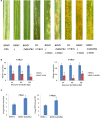TaMAPK4 Acts as a Positive Regulator in Defense of Wheat Stripe-Rust Infection
- PMID: 29527215
- PMCID: PMC5829626
- DOI: 10.3389/fpls.2018.00152
TaMAPK4 Acts as a Positive Regulator in Defense of Wheat Stripe-Rust Infection
Abstract
Highly conserved mitogen-activated protein kinase (MAPK) cascades regulate numerous plant processes, including hormonal responses, stress, and innate immunity. In this research, TaMAPK4 was predicted to be a target of tae-miR164. We verified the binding and suppression of TaMAPK4 by co-expression in Nicotiana benthamiana. Moreover, we found TaMAPK4 was localized in the cytoplasm and nucleus using transient expression analyses. TaMAPK4 transcripts increased following salicylic acid (SA) treatment and when host plants were infected with an avirulent race of the stripe-rust pathogen. Silencing of TaMAPK4 by virus-induced gene silencing permitted increased colonization by the avirulent pathogen race. Detailed histological results showed increased Puccinia striiformis (Pst) hyphal length, hyphal branches, and infection uredinial size compared to the non-silenced control. SA accumulation and the transcript levels of TaPR1, TaPR2, and TaPR5 were significantly down-regulated in TaMAPK4 knockdown plants. Overall, these results suggest that TaMAPK4 plays an important role in signaling during the wheat-Pst interaction. These results present new insights into MAPK signaling in wheat defense to rust pathogen.
Keywords: Puccinia striiformis; host defense mechanisms; mitogen-activated protein kinase; virus-induced gene silencing; wheat.
Figures





References
-
- Bartels S., Anderson J. C., Besteiro M. A. G., Carreri A., Hirt H., Buchala A., et al. (2009). MAP kinase phosphatase1 and protein tyrosine phosphatase1 are repressors of salicylic acid synthesis and SNC1-mediated responses in Arabidopsis. Plant Cell 21 2884–2897. 10.1105/tpc.109.067678 - DOI - PMC - PubMed
-
- Bethke G., Pecher P., Eschen-Lippold L., Tsuda K., Katagiri F., Glazebrook J., et al. (2012). Activation of the Arabidopsis thaliana mitogen-activated protein kinase MPK11 by the flagellin-derived elicitor peptide, flg22. Mol. Plant Microbe Interact. 25 471–480. 10.1094/MPMI-11-11-0281 - DOI - PubMed
LinkOut - more resources
Full Text Sources
Other Literature Sources

